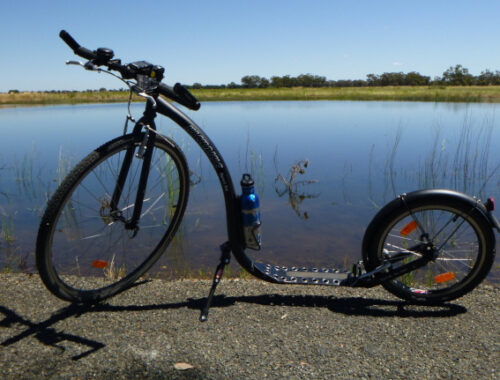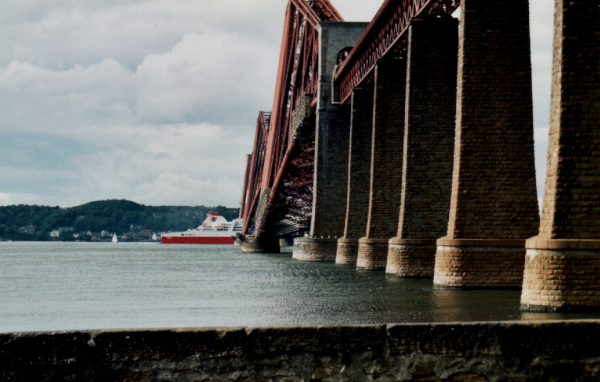Completion of the Lands End to John O’Groats Challenge
On 24th May 2021, I completed the Lands End to John O’Groats Virtual Challenge. While virtual kickbiking through the realm of the Scots, I received the following postcards and reached other points of interest.
23rd April 2021: Edinburgh Castle


“Edinburgh Castle [is] standing on top of a volcano.
It’s an extinct volcano – Castle Rock … was a prime area for a tribal hill fort from as early as the 2nd century AD.
An archaeological dig in the 1990s showed even earlier occupation, to at least the Iron and possibly even the Bronze age. Even the more recent settlement would make Castle Rock the oldest site in constant occupation in Scotland. Additionally, a few Roman finds would indicate that there was at the very least free trade across Hadrian’s Wall, if not any serious Roman settlement.
Central to almost all historical events that changed the course and face of Scotland forever, the Castle is still in full and active use – not only is it one of the few ancient castles in Britain still to have a garrison, but it is also a thriving visitor attraction. Should you happen to visit around lunchtime, listen out for the One O’Clock Gun, which is fired every day exactly on the hour of one, except for Sundays, Christmas Day, and Good Friday.
Part of Edinburgh’s World Heritage Site, the Castle achieved the ultimate in modern fame in 2009 – it appeared on the back of the Scottish 10 pound note, issued by Clydesdale Bank.” (From postcard email)
25th April 2021: Firth of Forth
The Firth of Forth (Scottish Gaelic: Linne Foirthe) is the estuary (firth) of several Scottish rivers including the River Forth. It meets the North Sea with Fife on the north coast and Lothian on the south. The word “Firth” is related to the word “fjord”, a Norse word meaning a narrow inlet. “Forth” stems from the name of the river; this is *Vo-rit-ia (meaning “slow running”) in Proto-Celtic, yielding Foirthe in Old Gaelic and Gweryd in Welsh. It was known as Bodotria in Roman times. In the Norse sagas it was known as the Myrkvifiörd. An early Welsh name is Merin Iodeo, or the “Sea of Iudeu”.
The Forth Bridge is a cantilever railway bridge across the Firth of Forth in the east of Scotland, 14 kilometres west of central Edinburgh. Completed in 1890, it is considered as a symbol of Scotland, having been voted Scotland’s greatest man-made wonder in 2016, and is a UNESCO World Heritage Site. It was designed by the English engineers Sir John Fowler and Sir Benjamin Baker.] It is sometimes referred to as the Forth Rail Bridge although this has never been its official name.
Construction of the bridge began in 1882 and it was opened in 1890 by the Duke of Rothesay, the future Edward VII. The bridge carries the Edinburgh–Aberdeen line across the Forth between the villages of South Queensferry and North Queensferry and has a total length of 2,467 metres. When it opened it had the longest single cantilever bridge span in the world, until 1919 when the Quebec Bridge in Canada was completed. It continues to be the world’s second-longest single cantilever span, with a span of 521 metres. (Sourced from Wikipedia)
6th May 2021: Loch Ness

“Loch Ness [is] Scotland’s second largest but deepest loch. No visit to Loch Ness is complete without a hunt for the famous monster, and boat tours set out regularly from various venues around the lake. There’s also a Loch Ness Exhibition at Drumnadrochit, which looks at the nature aspect of the water as well as the folklore surrounding it.
As for Nessie, well, she’s been around a while – or at least the legend has. Adomnan’s ‘Life of St. Columba’, written in the 6th century, tells of the Irish monk coming across a burial party on the banks of the River Ness, who tell him that the man was killed by being pulled under the Loch by a ‘water beast’. One of Columba’s own followers even encounters the monster when swimming across the water, although he escapes unscathed by making the sign of the cross.
In recent years, photographs – unexplained and proven hoaxes, films, and sightings on land combine to keep the mystery alive. Whether or not Nessie exists, the most conclusive evidence that there is – or at least was – something there comes from Robert Rines. A lawyer by profession, over a period of 35 years Rines assembled sonar readings which indicated that not only was it likely that something was there, that ‘something’ could be plural!
Sadly, toward the end of his life in 2009, Rines concluded that the species had become extinct, perhaps unable to adapt to global warming.” (From postcard email)
16th May 2021: Dunrobin Castle

“Rich in both mediaeval and Jacobite history, the castle itself was probably named after Robert, the 6th Earl of Sutherland, who died in 1427. Mediaeval Scotland was a largely tribal society, and the arch manipulator of the clans was Robert the Bruce, who planted the Gordon family – who were related to the legitimate Sutherland occupiers – in the castle temporarily to further his aims.
The Sutherlands (the Gordons changed their name) were in trouble again in the 18th century, providing unpopular support to the British government during the Jacobite Rebellion rather than to the popular Young Pretender Bonnie Prince Charlie. Escaping literally by the back door, the 17th Earl lived to fight another day and joined the Duke of Cumberland’s army.
In more recent times, the Castle has served both as hospital during the First World War, then after restoration from fire damage, as a school for a brief period in the 1960s and 1970s. Today, the Sutherland family still live there, and much of the Castle is open to the public between April and October. See if you can catch one of the falconry displays given in the Castle grounds.” (From postcard email)
23rd May 2021: Castle Sinclair Girnigoe

“This romantic ruin is the only castle in Scotland to be listed by the World Monuments Fund, and is subject to a significant preservation programme, to make sure that future generations can enjoy it.
You will find reference to both Castle Sinclair and Castle Girnigoe on maps, and there would appear to be two ruined castles, separated by a moat. However, a larger moat surrounds the whole site, and there is paperwork evidence to suggest that Fourth Earl of Caithness requested the name-change from Girnigoe to Sinclair in 1606, leading to both names being in common use. Ironically, the castle was said to have been destroyed by cannon fire by a later Sinclair in 1680, to stop it being seized to cover debts, although archaeological evidence would suggest significant occupation by Cromwell’s troops, who almost certainly started the demolition themselves.
Archaeological work is ongoing, so it’s worth checking in on the tangled history of this enigmatic ruin from time to time, as more evidence is uncovered as to not only its sad end, but its life and use.” (From postcard email)
24th May 2021 – John O’Groats

“Congratulations James, you’ve done it – here you are at John o’ Groats, at the northernmost tip of the Scottish mainland.
Dunnet Head is further north, of course, but there’s not much there except for a rather essential lighthouse. With Land’s End 876 miles (by highway) to the southwest, together they form the two most extreme inhabited towns on the British mainland.
John o’ Groats might sound like a fine Scotsman, but he was actually a Dutch settler – Jan de Groot – who came to the area in around 1489, and ran the ferry from the mainland to Orkney at the end of the 15th century, after the island had been returned to Scotland from Norwegian control in 1472.
Modern day John o’ Groats is, of course, something of a draw – in 2005, Lonely Planet described it as a ‘seedy tourist trap’, and you even needed to pay to have your photograph taken at the famous ‘Journey’s End’ signpost, which has its counterpart in Land’s End. Since 2013, the town has undergone considerable refurbishment, the hotel has re-opened, and photographs are now free. There is also still a regular boat service to Orkney, should you wish to extend your journey further.” (from postcard email).
Now that I have finished the Land’s End to John O’Groats challenge, the only virtual fitness challenge I am still doing is the Run Around Australia Challenge. So far I have reached Brisbane in that challenge, and am now heading west towards outback Queensland and eventually the Northern Territory. As I have posted about Brisbane and the surrounding region in the blog before I won’t add more about that here. The next major milestone on the Run Down Under challenge is more than 3000km away, in Katherine, Northern Territory. That 3000km is more than double the total I have walked in the challenge so far (about 1300km) and it probably will be more than a year before I reach that milestone at my current pace.
When Spring arrives, I am planning to do another Conqueror challenge on the Kickbike – the 772km Camino de Santiago in Europe.
You May Also Like



2 Comments
Sandra Rae Glew
Hello James,
Congratulations you have reached the tip of Scotland. I copied the postcards of Sinclair Castle to put on our familytree for Nan Glew’s mother as she was Jessie Sinclair Lyall – your great great grandmother. We go back to scottish heritage quite a way on both sides of our family.
Good walking with your walk around Australia.
Luv Sandy
Mum
Hi James,
Sinclair Castle was supposedly owned by our Sinclair ancestors. William Sinclair was the father of Janet Sinclair who married Henry Lyall, the 1st of our Lyall ancestors on Pa Glew’s side.
Mum